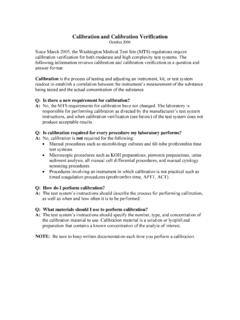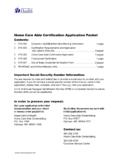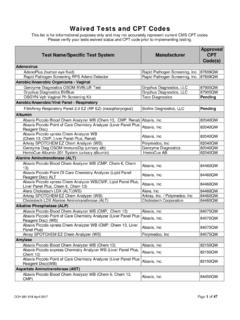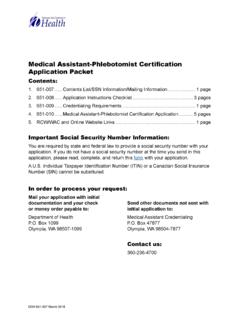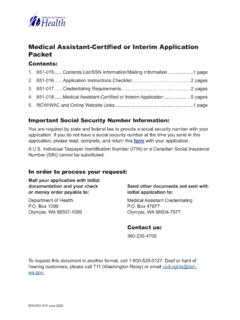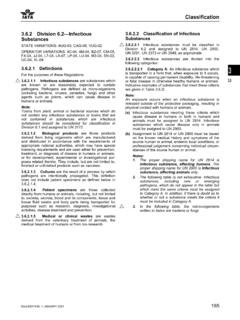Transcription of Point-of-Care Testing Guideline
1 PUB #681-NonDOH (July 2017) 1 Point-of-Care Testing guidelines Washington State Clinical Laboratory Advisory Council Originally published: October 2000 Reviewed/Revised: March 2005/March 2009/Sept 2013/July 2017 INTRODUCTION For many years, all or the majority of laboratory Testing was performed in a central laboratory. This was necessary due to the complexity of the Testing . With advances in technology, Testing has emerged from the laboratory to the patient s bedside, the pharmacy, the physician s office, the patient s home and other non-laboratory sites.
2 This Testing is called Point-of-Care Testing (POCT) and is defined as Testing at the point where patient care is given, wherever that is located. With this move outside the laboratory walls some problems occur that were not problems within the laboratory. Point-of-Care Testing often starts without knowing if the Testing is appropriate for the setting. There may be limited understanding of requirements for licensure, training, documentation, and procedures. Soon there may be several types of instrumentation performing the same Testing in various areas of a facility. There may be no evaluation or comparison of the values obtained from these different methodologies and they may not correlate well with each other.
3 Cost-savings that may be available through quantity purchasing may be lost. It is important that a Point-of-Care Testing Program at any of the above sites is carefully planned. REGULATIONS All sites performing laboratory Testing are regulated under the Clinical Laboratory Improvement Amendments of 1988 (CLIA) and must be licensed in order to perform any Testing . CLIA has granted deemed status to approved accreditation organizations and exempt states, and allows these entities to accredit or license Testing sites. All Point-of- care Testing must be covered by a Washington State Medical Test Site (MTS) license.
4 Washington State recognizes those accreditation organizations listed in Table 2. Many of the Point-of-Care Testing procedures are identified by CLIA as waived while others are moderately complex. A site performing only waived tests must have a Certificate of Waiver license but will not be routinely inspected. They must however adhere to manufacturer s instructions for performing the test. Good Laboratory Practice dictates appropriate quality Testing practices as outlined in the CLIA moderate and high complexity test requirements. These include training of Testing personnel, competency evaluation and performance of quality control.
5 Accreditation organizations such as Veteran s Administration and the College of American Pathologists (CAP) have stricter guidelines for waived and other Point-of-Care Testing than the CLIA regulations. As of 2009, The Joint Commission (TJC) now has a chapter on POCT. FOR EDUCATIONAL PURPOSES ONLY This document is intended as a guide for facilities to use in setting up a Point- Of- care Testing program. PUB #681-NonDOH (July 2017) 2 POINT- care Testing guidelines The following Guideline is a step-by-step outline that can be used in the development of a Point-of-Care program.
6 Although the outline is directed to a hospital or large institution Point-of-Care program, it may also be adjusted to smaller sites, such as a physician s office laboratory (POL). Recommendations will be included in the text covering problems unique to physician s office Point-of-Care Testing . OBTAIN AUTHORITY TO COORDINATE Point-of-Care Testing PROGRAM. Hospital, institution or medical clinic Point-of-Care Testing Authority to form a defined Point-of-Care program in this type of setting is usually needed since several departments and budgets are impacted. Regulatory agencies often mandate coordinated programs that includes an oversight committee.
7 A Physician Office Lab (POL) A physician may decide to perform laboratory Testing in the office. As the physician is ultimately responsible for his/her practice, the authority is implied. SELECT MEMBERS OF Point-of-Care COMMITTEE (POCC) Nothing is more important than having the right people on this committee no matter the size of the operation. Hospital, institution or medical clinic Point-of-Care Testing : It is important to involve those who have the responsibility and authority to implement the program. Members may include: a clinical pathologist as director or technical director/consultant, a physician as a medical director, nursing managers, a laboratory manager, educational coordinators, laboratory managers, quality assurance managers, pharmacy managers, and others who are needed to train end users, implement the Testing .
8 A specific Point-of-Care Supervisor/Coordinator is recommended for larger institutions to monitor test results. Purchasing and information technology representatives should serve as consultants to the committee. POL In a physician s office not only the physician, but also the Testing personnel should be involved in selecting the method or equipment that they will be using. The physician usually serves as the director; however, others who should be involved include the nurse, physician s assistant, and medical assistant. If there is a laboratory in the clinic, the laboratory manager or a staff member should be involved.
9 PUB #681-NonDOH (July 2017) 3 COMMITTEE DEVELOPS A Point-of-Care -PROGRAM Hospital, institution or medical clinic Point-of-Care Testing : A written Point-of-Care Program/Policy is important since Point-of-Care Testing tends to expand rapidly unless guidelines or policies are in place. The Program/Policy should clearly define: 1. Who is responsible for each part of the program naming key people? For example: Laboratory Point-of-Care Coordinator: keep database of Testing personnel, coordinate training of new personnel, choose Testing methods, monitor quality control and proficiency programs, provide ongoing coaching to Testing personnel in response to daily monitoring, consult on technical issues, and analyzer meter/troubleshooting.
10 Nurse Manager: enforce policies, schedule new employee training, take disciplinary action, if necessary, and schedule annual Point-of-Care competency evaluation of staff. Education dept. (if it exists): new employee training and annual certification of Testing personnel, support committee with agenda and minutes of meetings. Preferably training is done by those reviewing daily results and quality monitoring. Laboratory staff: new employee training, aid in annual certification of Testing personnel, download and/or review quality control data, verify equipment function and maintenance.
